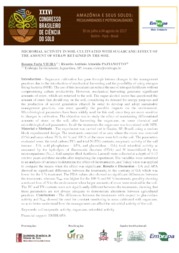Microbial activity in soil cultivated with sugarcane: effect of the amount of straw retained in the soil.
Microbial activity in soil cultivated with sugarcane: effect of the amount of straw retained in the soil.
Author(s): VIEIRA, R. F.; PAZIANOTTO, R. A. A.
Summary: Sugarcane cultivation has gone through intense changes in the management practices due to the introduction of mechanical harvesting and the possibility of using nitrogen fixing bacteria (NFB). The use of this inoculant can reduce the use of nitrogen fertilizers without compromising culture productivity. However, mechanical harvesting generates significant amounts of straw, which are returned to the soil. The sugar-alcohol sector has questioned the amount of straw that should stay on the soil, considering its demand for energy purposes and the production of second generation ethanol. In order to develop and adopt sustainable management practices, one must quantify the possible impacts on the environment. Microbiological parameters have been widely used for this end, since they are more sensitive to changes in cultivation. The objective was to study the effect of maintaining differentiated amounts of straw on the soil, after harvesting the sugarcane, on some chemical and microbiological soil parameters. In all the treatments the sugarcane was inoculated with NFB.
Publication year: 2017
Types of publication: Abstract in annals or event proceedings
Unit: Embrapa Environment
Keywords: Cana de açúcar, Soil enzymatic activity, Solo, microbial activity, sugarcane
Observation
Some of Embrapa's publications are published as ePub files. To read them, use or download one of the following free software options to your computer or mobile device. Android: Google Play Books; IOS: iBooks; Windows and Linux: Calibre.
Access other publications
Access the Agricultural Research Database (BDPA) to consult Embrapa's full library collection and records.
Visit Embrapa Bookstore to purchase books and other publications sold by Embrapa.

